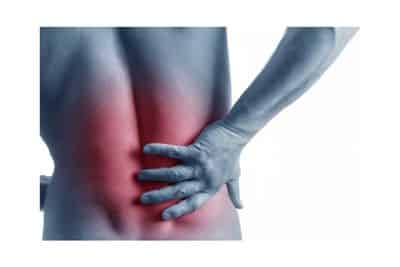Indeed, trampolining is a great way of exercise and fun. But, do you ever think it can be hazardous for your back? Don’t boggle! Let me explain. In-general trampoline isn’t bad for your back but you may accidentally hurt the back in some cases.
Some reasons of trampoline back pain are wrong landing posture, inexperienced bouncing, jumping with previous back pain like degenerative disc issues, etc. But it doesn’t mean you should never be on board a trampoline. By following some safety measures and proper trampoline methods you will be able to enjoy your trampoline sessions soon.
This article will explain different causes of trampoline back injuries and ways to get rid of these heartbreaking things.
Are Trampolines Bad for Your Back?

Can jumping on a trampoline cause back pain? Well, technically saying any kind of exercise or heavy activity can cause you back pain. Not serious ones always but a moderate level backache that may make you lazy to go exercising again.
So, in the case of trampolining the backache situation is going to be twice as painful as other regular exercises. While trampolining you go through an extreme jumping activity that creates extreme pressure on your back muscles that generally supports your spine.
And in case you already have back issues like a herniated degenerative disc disease, with a bit of muscle tightness then things are going to be worse for you. In this situation, the back is going to suffer more after trampoline sessions.
But does that mean the trampoline only has bad to offer your back? Not really. Exercise is always good for health and trampoline can also offer you tons of benefits.
Such as if you have a spondylolisthesis (a back condition of joints and ligaments that fails to hold your spines properly), a trampoline may help you to aid that. It can strengthen your joints and ligaments to stay in their best forms.
So, it can be said that a trampoline can actually work in both bad and good ways for you back. It can lead you to bad back injuries accidentally, while on the other side can improve the back bad conditions for a better life.
In short, we can say trampoline is not on a mission to damage your back. Rather, it is beneficial for your health and gives you a better body shape.
But the only alarming thing here is that if you are inexperienced in trampolines it can turn into a bad effect on you. A wrong landing or jumping without warm-up or a previous bad back can all make your trampoline experience bad.
So, my recommendation will always be to do a trampoline under the surveillance of an expert trampolinist and don’t exaggerate yourself on that jumping mat in the first days. Hopefully, you understand ‘is jumping on a trampoline bad for your back or not’.
See Also: Is rebounding before bed good?
Reasons of Back Pain After Trampoline
You may wonder, why does my back hurt after jumping on a trampoline? Well, you may already get a little bit of a hint about back pain trampoline causes. The main of them is unconsciousness of your landing posture or the destination of your landing. Plus, there can be some additional factors which are given below.
- Inexperienced in trampolining which causes you not to know how to perfectly land on feet while jumping.
- Landing with unnecessary bouncing on the front and rear legs while rebounding.
- Instead of legs, falling on the stomach or bending excessively forward or backward during the jump.
- If you have previous back pain, rebounding could make it more severe.
So, before you hop on the trampoline it’s important to learn proper landing techniques to resist any kind of center-back pain. Plus, depressing the bounce rate to get off the trampoline is also an important lesson to learn.
And if you somehow make it with the techniques, no warm-up before trampolining can be a bad option for your back as the muscles get strained.
Plus, being a newbie you should never go for a stunt on a trampoline, even for impressing your girlfriend or boyfriend. And if you have any kind of illness or physical damage, the trampoline is a big no no.
And the big “NO” is also for children under six and old citizens who should not get into a trampoline. Their bones are already fragile and can’t handle any kind of small injury.
See Also: How many calories does rebounder burn?
How to Diagnose Trampoline Back Pain?

1. How to Discern While Your Upper Back or Neck Has Been Injured?
If you encounter an upper back ache after trampolining, you have strained your back muscles or hurt your disks or ligaments.
There are the tricks how you can recognize your upper back injury:
- First and foremost, you will experience a scorching and searing pain in your upper back
- After that, you will feel muscle soreness and stiffness at an extreme level
- And to end, there will be a weakness in your arms and legs.
But don’t worry. Regular application of hot or cold bags, a good back massage, or even over-the-counter medications easily cures your upper back injury.
See Also: Trampoline injury explained
2. How to Discern While Your Middle Back Has Been Injured?
Recognizing middle back pain is going to be easier, as the issue is going to spread through all over your body. You will feel pain in your shoulders, neck, and hips with an executive amount of muscle pain.
Also, your arms and legs will show signs of weakness as they are connected to the middle back. And if you still can’t figure it out, see if there is any issue or numbness in your chest, belly, or extremities.
See Also: Can I use trampoline during period
3. How to Discern While Your Lower Back Has Been Injured?
Lower back pain is the most common one in trampoline users. As while trampolining the back, hips, and legs get the most impact, and try to save the spinal cord from getting that.
But in case you have a weak muscle in that area, you won’t be able to save your body from pain and end up having a lower back ache. In this kind of weak muscle situation, muscles work harder than normal ones to save the spine.
As a result, it stiffs up, causes muscle fatigue and discomfort. But in the worst situations, you may end up with strained muscle or spinal damage.
So, the must-keep in mind suggestion from me is to go slow on a trampoline. Especially when you are new to this adventure and aren’t aware of the after-effects. Just begin with perfecting good forms and moves, and then go beyond.
See Also: Rebounding attire guide
How to Get Rid of Trampoline Back Injury?

If your back is injured, you may look for effective ways to fix your back pain problem. Well, there can be many ways to cure or prevent your trampoline back injury.
Some of the recommendations to lessen backache are warming up before the trampoline, not overwhelming the trampoline, and also not doing any somersaults on the mat without experience.
But these are part of prevention. What about afterward?
So here’s what we can do to get relief from the bad back after jumping on the trampoline.
- First, inspect whether your spinal cord is curvature or not and also if the pain goes all over to the other side.
- Try to specify the area you are going through discomfort. Is it the upper back, lower back, or the center one?
- Once you determine your point of pain, now the first aid starts. Take a long warm shower to relieve the pain in your back.
- Try to apply the warm water directly to your hurting spot and it will be relieving the pain by relaxing the muscles. It is the most popular and efficient way to relieve pain in any part of your body.
- Despite this warm water bath, you can also have some moderate rehabilitation or stretching exercise to relieve the pain. But you have to be more careful about this exercise because one wrong move can increase your pain.
- Lastly, you can have some relaxing therapy to relax your tense muscles. But in case none of these ideas work, consult with a physician soon.
See Also: Trampoline yoga explained
Safety Tips to Avoid Back Injuries on Trampoline
- Wear a comfy sports suit that doesn’t bind your mobility and no need for shoes.
- Hop into the mat with an empty pocket and no sharp objects on hand.
- Make sure, the trampoline is leveled well, this will prevent injuries.
- Obviously, bounce on the center of the trampoline.
- During pregnancy and the menstrual cycle, women should avoid jumping.
- Children under six and old aged peoples are prohibited from trampolining.
- Warm up at least ten minutes before trampolining.
- Start with easy exercise first and then go for impressive stunts.
- Being a beginner takes small breaks during training as it will help you to restore your breath.
- And the most important fact. Don’t hop on a trampoline without having an expert on your side. First, learn the jumping techniques from a skilled coach and then try it on your own.
See Also: Trampoline with handle
Extra Tips to Get Releived from Center Back Pain

Center back pains can be a bit harsh one to recover but you can do it with proper care. Here are some tips to recover your back from those bad pains or the effects of an accident.
But in case you have chronic back pain I recommend you consult with a professional orthopedic doctor or chiropractor.
1. Put an Ice Bag
Well, I said earlier to apply hot water first to lower the pains on your back. But for harsh pains ice bags can work as magic. Many people may already know that technique that’s why I don’t highlight this too much here.
For any kind of inflammation or back injury, I recommend applying ice to the affected area within 24 to 48 hours.
2. Keep Moving
I know you are having bad back pain but that doesn’t mean you should stay in your bed the whole day. Try to move your body, and have some gentle walks so that your body can function normally.
Unless your body will get more stiffness on the backs and hips and moving will feel like a chore to you.
See Also: Rebounder for the lymph system
3. Drink Plenty of Water
Keep yourself hydrated with lots of water and water-based fruit or vegetables. If your spinal cord gets dehydrated, stiffness will increase on that part.
4. Massage Therapy
Massage therapy is always a great way to relax your body and remove pain. A professional therapist may help to trigger pressure points and knots to release the pain. Or you can do it at home by using some tennis balls or foam rollers over the pain area.
5. Make Use of an Extra Pillow
Use a pillow under your knees to sleep on your back or have it between your knees to sleep on a side. It will assist you to support your spine and reduce the chances of stiffness in your back.
See Also: Know how to flip on a trampoline
Frequently Asked Questions
1. How do you know if back pain is muscular?
Ans: The first symptom of muscular back pain is feeling pain or tightness in the chest. For that, you may experience severe pain in the backside during sleeping.
Although muscular back pain comes and goes. If the pain lasts about 3-6 months, your pain may spread from the neck to the upper back and lower back of your body.
2. Why does my back hurt when I jump up and down?
Ans: Well, if you are exercising the body is going to have pain for a little bit. But in this case, the back goes through pain as the heavy jumping activity creates tension on your spine.
It is a source of back soreness and if stays longer can create a severe medical injury like spinal fracture or stenosis.
3. What does a trampoline do to your spine?
Ans: While trampolining, our bodies go repetitive up and down which causes continuous stress to your spine and sends signals to your brain. The spine has to stay aligned to tackle heavy movements and if the impact goes harder, it can damage the spine.
See Also: How much does trampoline insurance cost?
Conclusion
Trampolining is a great way to exercise or have a fun adventure. But getting overboard can cause you severe pains in some parts of your body, such as the back. But it doesn’t mean you should restrain from the trampoline.
Just a bit of precaution and proper technique can minimize all the risks of having a severe accident and back injury. And in case of minor trampoline back pains keep your hot bath ready. So, get ready with your sportswear and happy trampolining!

Rebecca is a fitness nerd and mother. She was inspired to get into the world of trampolining and rebounding by her husband Robert, who is a well-respected trainer and expert in the field. Now she instructs children, mothers, and teens the basic trampolining and rebounding tricks.
Rebecca is also a passionate blogger, sharing her knowledge and experiences with others in the hope of encouraging them to give trampolining and rebounding a try.
